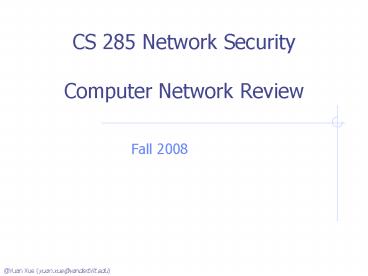CS 285 Network Security Computer Network Review PowerPoint PPT Presentation
1 / 19
Title: CS 285 Network Security Computer Network Review
1
CS 285 Network SecurityComputer Network Review
- Fall 2008
2
The goal of this lecture
- Suppose you want to build a computer network.
- What technologies would serve as the underlying
building blocks - what kind of software architecture would you
design to integrate these building blocks into an
effective communication service - what would be the weaknesses in the design that
may be exploited by attackers
3
Direct Link Network
- Point-to-point network
- Encoding
- Framing
- Error detection
4
Point-to-Point Network
- Encoding
- Turn binary data into the signals that the links
are able to carry, and then to transform the
signal back into the corresponding binary data at
the receiving node.
5
Point-to-Point Network
- Error Detection
- Bit errors can be introduced into frames due to
electrical interference or thermal noise. - Error detection detects transmission errors.
6
Multiple Access Network
- Media Access Control Protocol
- When the link is shared by multiple hosts, their
accesses to the link need mediation. - Ethernet -- CSMA/CD (Carrier Sense Multiple
Access / Collision Detection) - Participating hosts monitor the traffic on the
link. - If no transmission, the host can transmit.
- If two hosts attempt to transmit simultaneously,
this causes a collision, which is detected by all
participating hosts. - After a random time interval, the hosts that
collided attempt to transmit again. - If another collision occurs, the time intervals
from which the random waiting time is selected
are increased step by step. (exponential back
off)
7
Where the functions are implemented?
- Network adaptor
- encoding, framing, error detection, and media
access control. - MAC Address
- In Ethernet, each adaptor has a unique Ethernet
address, which is also the MAC address of the
corresponding host.
8
Where the functions are implemented?
- Packet reception
- Each frame transmitted on an Ethernet is received
by every adaptor connected to that Ethernet. - Each adaptor recognizes those frames addressed to
its own address, and passes only those frames to
the host. - An adaptor can also be programmed to run in
promiscuous mode, in which case it delivers all
received frames to the host.
9
Where does the security issue come from?
- Frequency jamming
- Eavesdropping (e.g., packet sniffing)
- MAC address spoofing
- Etc.
10
From Direct Link Network To InterNetworking
11
InterNetworking
- Issues
- Heterogeneity
- internetwork connects networks with different
technologies - Scale
- the Internet doubled in size each year for 20
years. - Solution
- Internet Protocol (IP) is the key tool to build
scalable, heterogeneous internetworks. - Functions
- Addressing
- Fragmentation and Reassembly
- Routing and Forwarding
12
Addressing
- Addressing
- providing suitable identifiers for all these
hosts in internetworks. - Hierarchical addresses
- a network part a host part.
- Address classes
- flexibility, allowing networks of vastly
different sizes to be accommodated fairly
efficiently.
13
Fragmentation and Reassembly
- Problem
- Each network technology has its own definition of
packet size. - Solution
- packets can be fragmented and reassembled when
they are too big to cover a given network. - Each IP datagram is re-encapsulated for each
physical network over which it travels.
14
Routing and Forwarding
- Forwarding
15
Routing and Forwarding
- Routing
- Distance vector
- Link state
16
Internet Routing
- Internet is organized into autonomous systems
- provide hierarchically aggregate routing
information in a large internetwork to improve
scalability. - intra-domain routing within a single autonomous
system - RIP and OSPF are used for intra-domain routing
- inter-domain routing between autonomous systems.
- BGP (Border Gateway Protocol) is the routing
protocol used in Internet for inter-domain
routing.
17
More Security Issues
- IP spoofing
- Authentication of routing messages
- Etc
18
End-to-End Protocols
- Problem
- turn this host-to-host packet delivery service
into a communication channel between application
processes. - End-to-end protocols of Internet
- UDP and TCP
19
Network Architecture

